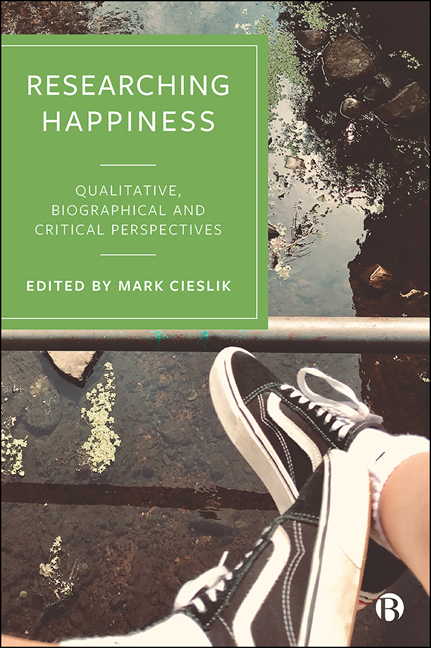Book contents
- Frontmatter
- Contents
- List of Figures and Tables
- Notes on Authors
- 1 Introduction: Developing Qualitative Research into Happiness and Wellbeing
- Part I Qualitative Research into Happiness/Wellbeing: Theories, Debates and Issues
- Part II Qualitative Research into Happiness/Wellbeing: Communities, Biographies and Identities
- Part III Qualitative Research into Happiness/Wellbeing: Methodological Innovations
- Index
1 - Introduction: Developing Qualitative Research into Happiness and Wellbeing
Published online by Cambridge University Press: 22 December 2021
- Frontmatter
- Contents
- List of Figures and Tables
- Notes on Authors
- 1 Introduction: Developing Qualitative Research into Happiness and Wellbeing
- Part I Qualitative Research into Happiness/Wellbeing: Theories, Debates and Issues
- Part II Qualitative Research into Happiness/Wellbeing: Communities, Biographies and Identities
- Part III Qualitative Research into Happiness/Wellbeing: Methodological Innovations
- Index
Summary
Sociology and qualitative research into happiness/wellbeing
There are always difficulties choosing cover images for books, particularly for one on wellbeing given the elastic, ephemeral nature of happiness. It is important for the image to be appealing, conveying something of the contents and attracting readers. Many happiness books employ banal symbols of fun, joy and leisure pursuits. Bright yellow covers, smiley emojis, dancers, beaches and mountains, fairgrounds and clowns all feature on recent texts. Such common-sense images of fun obscure the complexities of people's lives and the life-long struggle to live well. Hence the less obvious cover image selected for this book. What does a pair of legs hanging lazily over the side of bridge say about this book and how we study happiness? The image taken of my 14-year-old son Theo, who was staring into a Scottish stream, encapsulates many of the themes we explore across the following eleven chapters. With a little bit of interpretative effort we can read this image as one about ‘having time’, to sit and enjoy the wonders of nature. Hidden in this shot are family members so the book is also about these pivotal relationships that carry us through life. The book is concerned with these nourishing and restorative moments that inform wellbeing in real time and imaginatively as we hold on to these memories through life. These moments are often about connections, to people, places and activities that are ingredients of a good life – that which makes life worth living. Hence the book is very much about ‘social happiness’ and using qualitative or ethnographic techniques to document the flow of relationships and evolving identities central to wellbeing. In investigating the spectrum of experiences and emotions important for wellbeing (from suffering to the sublime) the book is also curious about being human – what humans need to feel alive and how we create better societies that foster these experiences. The running waters of the stream that so captivated Theo symbolizes another important theme of this book around the notion of movement and journeys – people's daily routines; moving places seeking happier lives; people aging, moving through stages in life all shaping the ebb and flow of wellbeing. The book also examines how individuals and their happiness are conditioned by the environments in which they live, social policies and their social backgrounds.
- Type
- Chapter
- Information
- Researching HappinessQualitative, Biographical and Critical Perspectives, pp. 1 - 18Publisher: Bristol University PressPrint publication year: 2021



